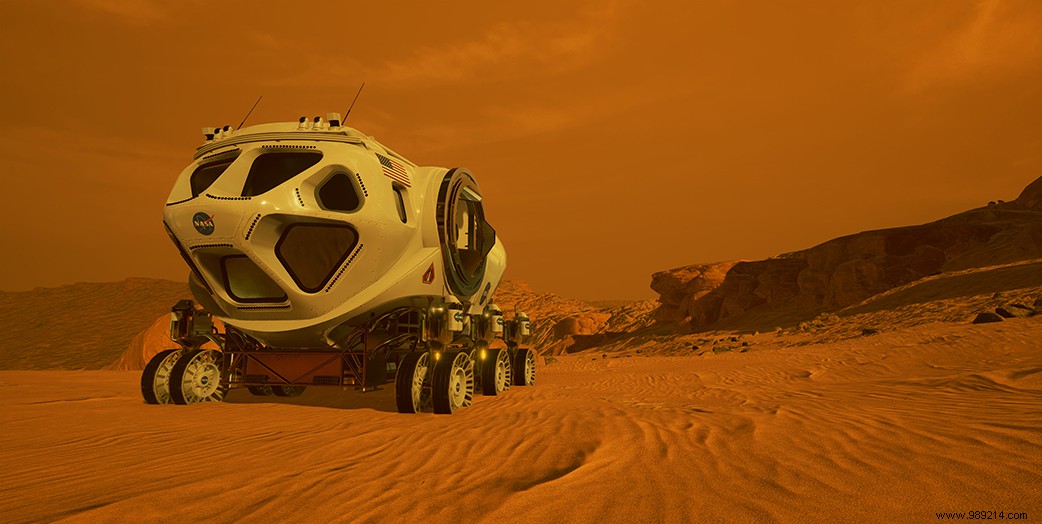NASA is planning a first manned mission to Mars at the end of the 2030s. But to do this, it will have to think about and develop another means of propulsion. Something to shorten travel times in space.
To leave Earth, operating agencies and companies have always relied on conventional rockets known as chemical propulsion . This involves the production of large quantities of matter in gaseous form in a combustion chamber. Exposed to high temperatures and high pressures, these gases are then expanded in a nozzle and ejected at high speed at the rear of the engine. This helps to create the "push" necessary to extract ourselves from the earth's gravity which is "pulling" us down.
This technology has allowed us human exploration of the Moon. And if NASA does indeed intend to return there, it also has other plans in mind:human exploration of Mars. In this spirit, chemical propulsion then poses a problem. With current technology, it would indeed take about six to nine months to send Men to Mars and a phenomenal amount of thrusters needed.
And even if we could do that, such missions would be prohibitively expensive and the red planet would mark some kind of limit beyond which we could not go. So, to go further, you have to go faster, with less fuel. And to do this, we must indeed think of another means of propulsion.
In this sense, the solution could come to us from nuclear energy. At NASA's request, a new report from the National Academies of Sciences, Engineering, and Medicine recently assessed the viability of two means of propulsion, nuclear thermal andelectric nuclear , for a human mission launched on Mars in 2039.
"One of the main conclusions of the report is that if we want to send humans to Mars, and we want to do so repeatedly and sustainably, nuclear space propulsion is the solution “, said Bobby Braun, of the Jet Propulsion Laboratory.
Each of these technologies relies on nuclear reactions, but works differently. Nuclear thermal propulsion involves a rocket engine in which a nuclear reactor replaces the combustion chamber and burns liquid hydrogen as fuel. Nuclear electric propulsion, on the other hand, converts heat from a fission reactor into electrical energy, then uses that energy to produce thrust by accelerating an ionized propellant (xenon type).
Nuclear propulsion requires much less fuel than chemical propulsion (less than 500 metric tons versus 1,000 to 4,000 metric tons for SLS ). In addition, it would make it possible to reach Mars more quickly.
In recent years, NASA has not really focused on this type of technology. This is likely because the space agency is invested in the development of its SLS rocket, which is chemically powered. However, if the agency wants to rely on nuclear propulsion for these first manned Martian missions, the report says it needs to jump right into developing the technology.
It won't be an easy task. Different configurations have indeed already been proposed since the beginning of the space age, but no rocket using this type of propulsion has yet succeeded in flying . Let it be said, this type of technology is very, very complicated to develop.
Two years ago, the US Congress allocated a budget of 125 million dollars (about 112 million euros) to NASA to allow this research. However, Bobby Braun points out that it would cost much more to develop this technology and begin cargo flights to Mars in the mid-2030s.

What about the Starship that SpaceX is building to send humans to Mars? The company's engineers know that it will take a lot of fuel to reach Mars, but they think the problem can be solved if the ship concerned is able to fly often and at low cost. This is why SpaceX is developing a reusable launch system , based on its experience acquired over the past five years.
Concretely, the idea is to release a Starship in low Earth orbit, with empty tanks, using a Super Heavy launcher. It then returns to Earth to launch a new fuel-filled Starship (a tanker version). This tanker vessel finally docks with the Starship in orbit to transfer fuel to it, allowing it to begin its long journey to the red planet.
NASA is not taking advantage of this essential reuse experience for SpaceX. That's why she has to focus on another strategy.